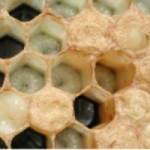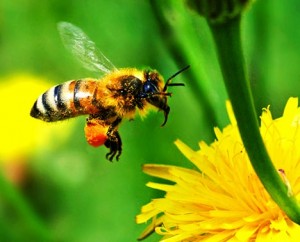 The alimentary canal of a bee larvae is not as complex and developed as that of a fully grown bee (see Honey Bee Alimentary System), but still has to function efficiently to ensure nutrients are absorbed quickly to aid the larvae’s rapid growth and ensure that it has sufficient body stores to last it through the sealed pupal stage and onto its emergence as an adult honey bee. Bee larvae have voracious appetites and are fed first larvae royal jelly, then are quickly weaned onto a mixture of honey and pollen (bee bread) by adult worker (nurse) bees. Of course if the larva is to become a queen, royal jelly will continue to be fed to it.
The alimentary canal of a bee larvae is not as complex and developed as that of a fully grown bee (see Honey Bee Alimentary System), but still has to function efficiently to ensure nutrients are absorbed quickly to aid the larvae’s rapid growth and ensure that it has sufficient body stores to last it through the sealed pupal stage and onto its emergence as an adult honey bee. Bee larvae have voracious appetites and are fed first larvae royal jelly, then are quickly weaned onto a mixture of honey and pollen (bee bread) by adult worker (nurse) bees. Of course if the larva is to become a queen, royal jelly will continue to be fed to it.
The bee larva has a very short fore-gut which carries the food from its mouth to its mid-gut, in which the food is digested. Up until the end of its larval period, that is until it has finished feeding and before it is sealed up to pupate, the mid-gut has no exit to the hindgut and digested food residue remains there. This is believed to be to prevent it from fouling its food.
Once the larva is fully fed the hind-gut breaks through into the mid-gut. At the same time the Malpighian tubules which act like kidneys and have being removing nitrogenous waste from the body cavity also break through and discharge their contents, thereby adding uric acid to the feacal matter. This waste is then expelled from the larva and spread over the walls of the brood cell. It is then covered with the silken cocoon that the larva is now spinning.
On emerging from her cell as an adult, one of the first things the bee does even before eating is clean out her birth cell. Ensuring that all her waste matter is removed and the cell is ready to be reused.
More Bee Anatomy and Physiology

